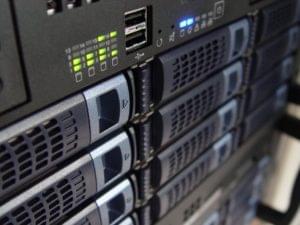I have two theories about the Internet.
Theory #1: Smart people build the Internet, smarter people manage the Internet, but technically challenged people use it.
Theory #2 Web sites have a natural progression. They start off on a free server, then they move to a paid virtual host and at some point will have a domain name. From here, they move up to a better virtual host, and then migrate to a virtual server. Once they reach this point the only step left is to move to a dedicated server or even multiple servers depending on the configuration. The dedicated server can be leased, managed, or simply co-located at a Data Center.
As much as I’m sure you’d love for me to expand on theory #1 I will be spending my time going over the intricacies of theory #2. More importantly, I’m going to skip over the free, virtual host, and virtual server and dive right into the big daddy of dedicated hosting.
First, let me tell you how this article will evolve. You see, like the Internet, this article is changing even as you are reading it. Heck, it’s changing as I write it. I cannot give you a solid idea of what will be next, but I will do my best to prepare you for what’s coming up. With that, in mind let’s get started on my journey into the world of dedicated hosting….
The first thing most people will consider when going dedicated is price (please note for article purposes the single word “dedicated” encompasses dedicated, managed, and collocated servers). While this is important and your budget is a big concern, you actually have a lot more planning to do. People that shop on price alone and try to find the cheapest guy with all the “cool” stuff are in for a hard lesson.
The Operating System
So, what is the biggest decision I had to make? Operating System. Yes, I know many of you are screaming at me for even considering Win 2K vs. *nix BUT I had to consider all my options. So what did I choose? Well, like most web servers out there I went with a *nix flavor. Red Hat 6.2 to be exact. Why? Budget was a huge consideration for me, as it will undoubtedly be for many of you. Since, I wanted to spend more money on the hardware, and toys I figured I could save big bucks by going with a free Operating System.
I choose Red Hat for its huge installed base in the industry and wide support channels. That and the fact that most people know Red Hat, it’s well documented and the idea of RPM’s (yes I know that the other flavors have packaging systems) appealed to me from the start.
** Quick Note **
RPM – Red Hat Package Manager – This is an easy and fast way to install software and programs onto a Red Hat system (or RPM enabled system). An RPM will allow one command installation and de-installation with out the need for “make” files, lengthy pre-configuration, and compiling. In other words, it’s a great tool for Linux novices.
** End Note **
The System
Now that I had the Operating System sorted, I moved onto the mechanic’s of the server itself. This lead to the next big question: What kind of system did I want? A dedicated server, a managed server, or collocated server? For some, this is an easy choice based again on your budget. For others it’s a knowledge issue, and still others see it as a control issue.
Definitions:
Collocated Server – This is when you build or purchase a server then place it (aka collocate) it at a data center. The hosting company is not responsible for any aspect of the server other than to provide it with power, and Internet connectivity.
Pros: You own the hardware and software and have 100% control over everything.Cons: You will receive no free support from the hosting company.
Dedicated Server – This is when you lease a server from a company and this company is responsible for the hardware of the server and you are responsible for the software.
Pros: You don’t have to worry about hardware failures or doing upgrades on the hardware since the hosting company will retain responsibility for this.Cons: Typically a higher monthly cost. You are also forced into using whatever hardware the hosting company offers. (I.e. AMD over Intel processors). You are typically charged for hardware upgrades in the form of a monthly recurring fee.
Managed Server – A managed server is one that the hosting company retains full control over. You will simply provide the data for the server and dictate how the maintenance of this server will be handled. Typically the client has no root access and cannot add or remove programs without the authorization of the hosting company.
Pros: In general, you have to little to worry about since the hosting company will take all the hardware, software, and security issues under their belts. This leaves you more time to concentrate on the site development and less on the administration of the serverCons: Typically the most expensive option. You really have less control over the daily operations of the server than with the other two options. However, this is needed in order for the hosting company to deliver on its promises of uptime, security, etc.
My Solution
So what did I chose and why? Well, as much as I would have like to have gone with a dedicated server I chose the collocated server instead. The managed server for this article was kind of silly but it was a nice dream for about 3 seconds (rewrite the sentence prior to this). Another big factor in my decision was price. For me, it was also circumstance, since I have a data center just around the corner from me, so I couldn’t pass up the opportunity.
The Hardware
So I had my OS and I had picked out how I want the server to be hosted. The final step in this process was to pick out the hardware and the server style. Again we’ll need some definitions here:
White Box Server (AKA shelf mount) – For this I want you to look down at your computer. That is a white box server. These are typically the home built servers and are the cheapest to manufacture.
Pros: Easily built, upgraded, and maintained since we’ve all tinkered with our home computers.Cons: Hosting companies will typically charge you more for this type of server depending on its size. Also, since this server has to be place on a shelf system it’s more susceptible to being “moved” around by passer-by’s.
Rack Mount Server – This is what you see whenever you look at a hosting companies server room. Columns and columns of these servers will be lined up next to each other in their racks. This is also the type of server most hosting companies will lease out.
Pros: Typically they are easier to mount and many hosting companies will accept them with open arms. Also pricing for these types of servers is based on a per U basis. 1U is about 1 3/4 inch tall.Cons: Typically these servers are harder to upgrade unless you’ve spent some money up front for Hot Swap items (i.e. Hard Drives etc).
I chose to go with the rack-mounted server. I will be using an Intel ISP 1100. It will be equipped with an Intel PIII 800 Mhz processor, 128 Megs of RAM, and a 20 Gig IDE HD.
Now with that out of the way, we can start installing software. When next we meet we’ll talk about picking extra software and, of course, the installation of this software and the Operating System.
Frequently Asked Questions about Web Hosting Options
What are the different types of web hosting services available?
There are several types of web hosting services available, each designed to meet different needs. These include shared hosting, where your website shares resources with other websites on the same server; dedicated hosting, where your website has its own server; VPS hosting, which is a hybrid of shared and dedicated hosting; and cloud hosting, where your website is hosted on a network of servers. Other types include reseller hosting, where you can sell hosting services to other people, and managed hosting, where the hosting provider takes care of all the technical aspects of running a website.
How do I choose the right web hosting service for my needs?
Choosing the right web hosting service depends on your specific needs. Consider factors such as the amount of traffic you expect, the level of technical expertise you have, your budget, and the type of website you want to host. For example, a small personal blog may do well with shared hosting, while a large e-commerce site may require dedicated hosting.
What is the difference between a domain name and web hosting?
A domain name is the address of your website on the internet, while web hosting is the service that makes your website accessible on the internet. You need both to have a functioning website. The domain name is what people type into their browser to visit your website, while the web hosting service stores all the files and data of your website.
How does pricing work for web hosting services?
Pricing for web hosting services can vary greatly depending on the type of hosting you choose and the specific features you need. Shared hosting is typically the cheapest option, while dedicated hosting is the most expensive. Many hosting providers offer tiered pricing plans, where you pay more for additional features or resources.
What is uptime and why is it important in web hosting?
Uptime refers to the amount of time that a server is up and running. It’s important in web hosting because it affects the availability of your website. If a hosting provider has a high uptime percentage, it means that their servers are reliable and your website is likely to be accessible most of the time.
What is bandwidth in web hosting and why does it matter?
Bandwidth in web hosting refers to the amount of data that can be transferred between your website and its users in a given period of time. It matters because it affects the speed and performance of your website. If your website has a lot of traffic or heavy media content, you’ll need more bandwidth to ensure a good user experience.
What is the role of a control panel in web hosting?
A control panel in web hosting is a web-based interface that allows you to manage your hosting account. It lets you perform tasks like installing applications, setting up email accounts, managing databases, and monitoring your website’s performance.
What is SSL and why is it important for my website?
SSL (Secure Sockets Layer) is a security protocol that encrypts data transferred between a user’s browser and your website. It’s important because it protects sensitive information like credit card numbers and login credentials from being intercepted by hackers. Having an SSL certificate also boosts your website’s credibility and can improve its ranking in search engine results.
Can I switch my web hosting provider if I’m not satisfied?
Yes, you can switch your web hosting provider if you’re not satisfied with their service. Most hosting providers offer a money-back guarantee period, during which you can cancel your account and get a refund. After this period, you can still switch providers, but you may not get a refund.
What is the difference between Linux and Windows hosting?
Linux and Windows are two different operating systems used by servers. The main difference between them is the type of applications they support. Linux hosting supports applications like PHP, Perl, and MySQL, while Windows hosting supports ASP.NET, MSSQL, and other Microsoft applications. Your choice between the two should depend on the applications and technologies you plan to use on your website.




